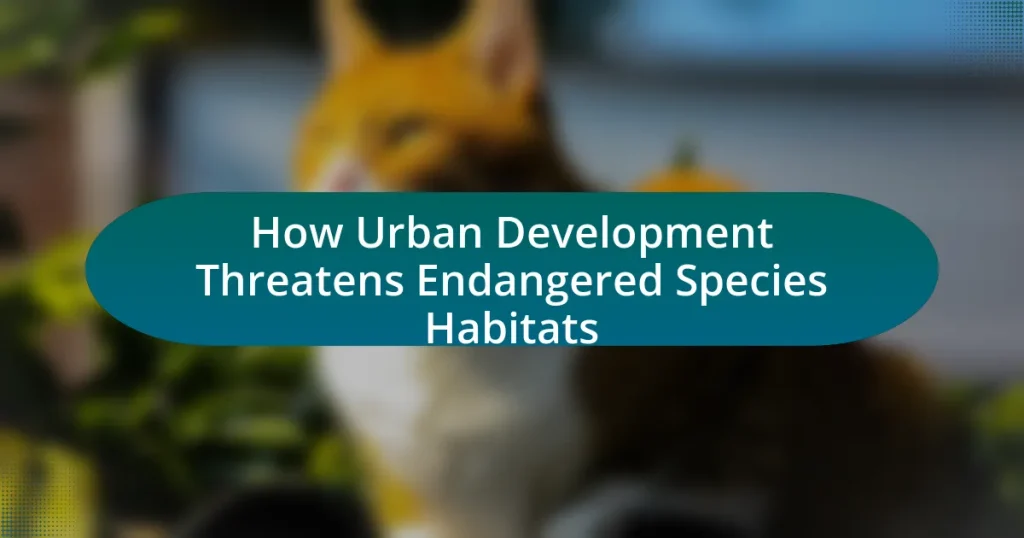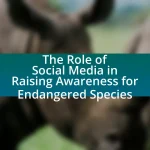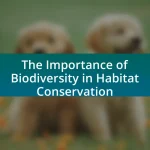Urban development poses significant threats to endangered species habitats through habitat loss, fragmentation, pollution, and the introduction of invasive species. As cities expand, natural landscapes are converted into urban areas, leading to a drastic reduction in available habitats for various species, with studies indicating up to a 50% decrease in habitat area for some. This article examines the primary ways urban development impacts local ecosystems, the specific endangered species affected, and the long-term consequences of biodiversity loss. It also discusses strategies for managing urban development to protect these vital habitats, highlighting successful case studies and practical steps individuals can take to support conservation efforts.

How does urban development impact endangered species habitats?
Urban development significantly impacts endangered species habitats by leading to habitat loss, fragmentation, and degradation. As cities expand, natural landscapes are converted into residential, commercial, and industrial areas, which reduces the available space for endangered species to thrive. For instance, a study published in the journal “Biological Conservation” found that urbanization can lead to a 50% reduction in habitat area for certain species, making it difficult for them to find food, mates, and shelter. Additionally, the construction of roads and buildings can fragment habitats, isolating populations and hindering their ability to migrate or interbreed, which is crucial for genetic diversity. This combination of habitat loss and fragmentation poses a direct threat to the survival of endangered species.
What are the primary ways urban development threatens these habitats?
Urban development primarily threatens habitats through habitat destruction, fragmentation, pollution, and the introduction of invasive species. Habitat destruction occurs when land is cleared for construction, leading to the loss of native flora and fauna. Fragmentation results from the division of habitats into smaller, isolated patches, making it difficult for species to migrate, find mates, or access resources. Pollution from urban areas contaminates air, water, and soil, adversely affecting the health of wildlife and their ecosystems. Additionally, urban development often facilitates the spread of invasive species, which can outcompete native species for resources, further endangering local biodiversity. These factors collectively contribute to the decline of endangered species and the degradation of their habitats.
How does land conversion for urban use affect local ecosystems?
Land conversion for urban use significantly disrupts local ecosystems by fragmenting habitats, reducing biodiversity, and altering natural processes. This transformation often leads to the loss of native species as their habitats are destroyed or degraded, with studies indicating that urbanization can decrease species richness by up to 75% in affected areas. Additionally, the introduction of impervious surfaces changes water runoff patterns, which can lead to increased flooding and erosion, further harming local flora and fauna. Urban development also typically introduces pollutants and invasive species, compounding the stress on native ecosystems.
What role does pollution from urban areas play in habitat degradation?
Pollution from urban areas significantly contributes to habitat degradation by introducing harmful substances into ecosystems. This pollution, which includes chemicals, heavy metals, and waste products, disrupts the natural balance of habitats, leading to loss of biodiversity. For instance, studies have shown that runoff from urban areas can contaminate waterways, adversely affecting aquatic life and reducing species populations. Additionally, air pollution from urban environments can harm plant life, further diminishing habitat quality. The degradation of these habitats ultimately threatens the survival of endangered species that rely on these ecosystems for their existence.
Why is it important to protect endangered species habitats from urban development?
Protecting endangered species habitats from urban development is crucial to ensure the survival of these species. Urban development often leads to habitat destruction, fragmentation, and pollution, which can severely impact the ecosystems that endangered species rely on for food, shelter, and breeding. For instance, the International Union for Conservation of Nature (IUCN) reports that habitat loss is one of the primary drivers of species extinction, with approximately 80% of threatened species facing habitat degradation. By safeguarding these habitats, we maintain biodiversity, which is essential for ecosystem resilience and overall environmental health.
What ecological functions do these habitats serve?
Endangered species habitats serve critical ecological functions such as biodiversity preservation, carbon sequestration, and water filtration. These habitats support a variety of plant and animal species, contributing to ecosystem stability and resilience. For instance, wetlands act as natural water filters, removing pollutants and improving water quality, while forests sequester carbon, mitigating climate change impacts. Additionally, these habitats provide essential services like pollination and soil fertility, which are vital for maintaining healthy ecosystems. The loss of these habitats due to urban development directly threatens these ecological functions, leading to decreased biodiversity and compromised ecosystem services.
How does the loss of biodiversity affect human communities?
The loss of biodiversity negatively impacts human communities by disrupting ecosystem services essential for survival, such as food production, clean water, and disease regulation. For instance, a decline in pollinator species can lead to reduced crop yields, threatening food security for populations reliant on agriculture. Additionally, biodiversity loss can increase vulnerability to natural disasters; diverse ecosystems, like wetlands, provide natural flood protection. Research indicates that areas with higher biodiversity are more resilient to environmental changes, thus supporting community stability and health.
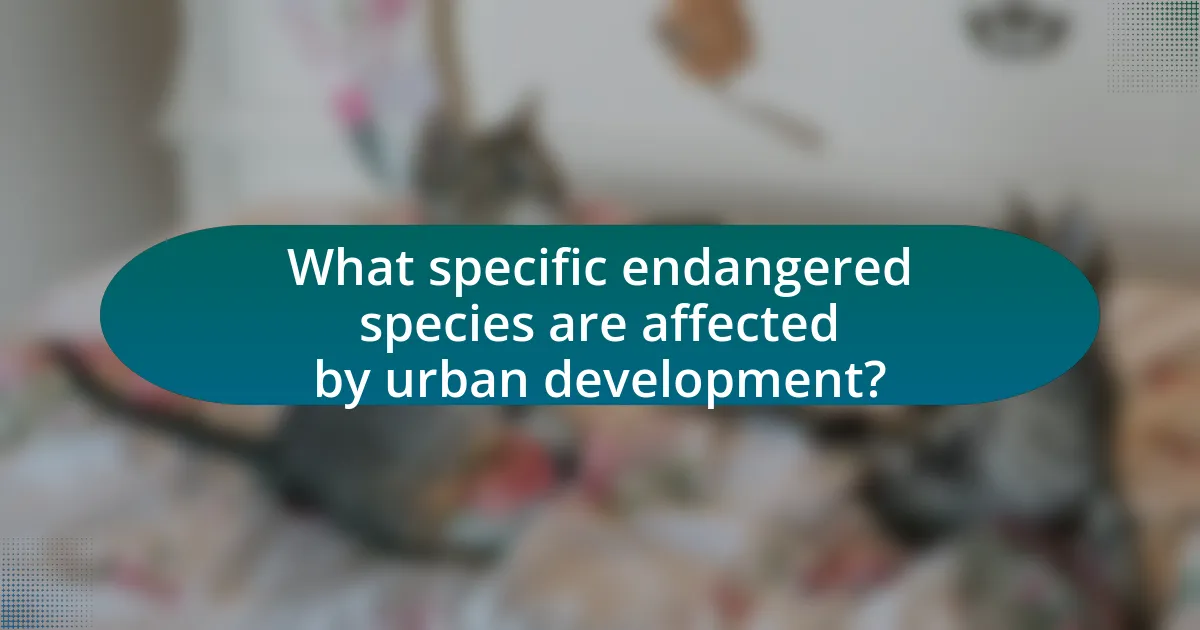
What specific endangered species are affected by urban development?
Specific endangered species affected by urban development include the California condor, the Florida panther, and the Eastern box turtle. Urban development leads to habitat loss, fragmentation, and increased human-wildlife conflict, which directly threaten these species. For instance, the California condor’s population has been severely impacted by habitat destruction due to urban expansion, resulting in a decline in their natural nesting sites. Similarly, the Florida panther faces habitat fragmentation from roads and urban areas, which limits their movement and breeding opportunities. The Eastern box turtle is also affected as urbanization reduces their habitat and increases mortality rates from vehicle collisions.
Which species are most at risk due to urban expansion?
Urban expansion poses significant risks to various species, particularly those that are already endangered or vulnerable. Species such as the California tiger salamander, the Florida panther, and the Eastern box turtle are among the most affected. Urban development leads to habitat loss, fragmentation, and increased human-wildlife conflict, which directly threaten their survival. For instance, the California tiger salamander’s breeding habitats are increasingly encroached upon by housing developments, leading to population declines. Similarly, the Florida panther’s range has been severely restricted due to urban sprawl, resulting in a critical reduction in genetic diversity. These examples illustrate the direct correlation between urban expansion and the heightened risk faced by these species.
What are the characteristics of these endangered species?
Endangered species typically exhibit characteristics such as low population numbers, limited geographic range, and specific habitat requirements. These traits make them particularly vulnerable to threats like habitat destruction caused by urban development. For instance, the California condor, with a population that dwindled to just 27 individuals in the 1980s, requires large, undisturbed areas for nesting and foraging, which urban expansion disrupts. Additionally, many endangered species have specialized diets or reproductive behaviors that further limit their adaptability to changing environments, as seen in the case of the Florida panther, which relies on a specific ecosystem that is increasingly fragmented by human activities.
How do urban areas disrupt the life cycles of these species?
Urban areas disrupt the life cycles of endangered species by fragmenting their habitats, which limits access to essential resources such as food, shelter, and breeding sites. This fragmentation often leads to isolated populations that struggle to survive due to reduced genetic diversity and increased vulnerability to environmental changes. For instance, urbanization can create barriers like roads and buildings that prevent species from migrating to areas necessary for their life cycles, such as breeding grounds or seasonal feeding areas. Studies have shown that species like the Florida panther have experienced significant declines in population due to habitat loss and fragmentation caused by urban development, highlighting the direct impact of urban areas on their life cycles.
What are the consequences of losing these endangered species?
Losing endangered species leads to significant ecological imbalance and loss of biodiversity. The extinction of these species disrupts food chains and ecosystems, as each species plays a unique role in its habitat. For instance, the loss of pollinators like certain bees can result in decreased plant reproduction, affecting food sources for other animals and humans. Furthermore, endangered species often contribute to ecosystem services such as water purification and climate regulation; their disappearance can compromise these vital functions. According to the World Wildlife Fund, the extinction of species can lead to a 10% decline in ecosystem productivity, demonstrating the critical importance of maintaining biodiversity for ecological health.
How does species extinction impact ecosystem balance?
Species extinction disrupts ecosystem balance by removing key species that contribute to ecological functions. When a species disappears, it can lead to overpopulation of other species, loss of biodiversity, and altered food webs. For example, the extinction of a predator can cause an increase in herbivore populations, which may overgraze vegetation, leading to habitat degradation. This phenomenon has been observed in various ecosystems, such as the decline of wolves in Yellowstone National Park, which resulted in an overpopulation of elk and subsequent vegetation loss. Such imbalances can ultimately affect ecosystem services, including water purification, pollination, and climate regulation, demonstrating the critical role each species plays in maintaining ecological stability.
What are the long-term effects on urban environments?
The long-term effects on urban environments include habitat fragmentation, increased pollution, and altered local climates. Habitat fragmentation occurs as urban areas expand, isolating wildlife populations and reducing biodiversity. Increased pollution from vehicles and industrial activities leads to degraded air and water quality, adversely affecting both human health and ecosystems. Additionally, urbanization contributes to the urban heat island effect, where cities become significantly warmer than surrounding rural areas, impacting local weather patterns and species survival. These changes collectively threaten the habitats of endangered species, as they rely on stable ecosystems for their survival.
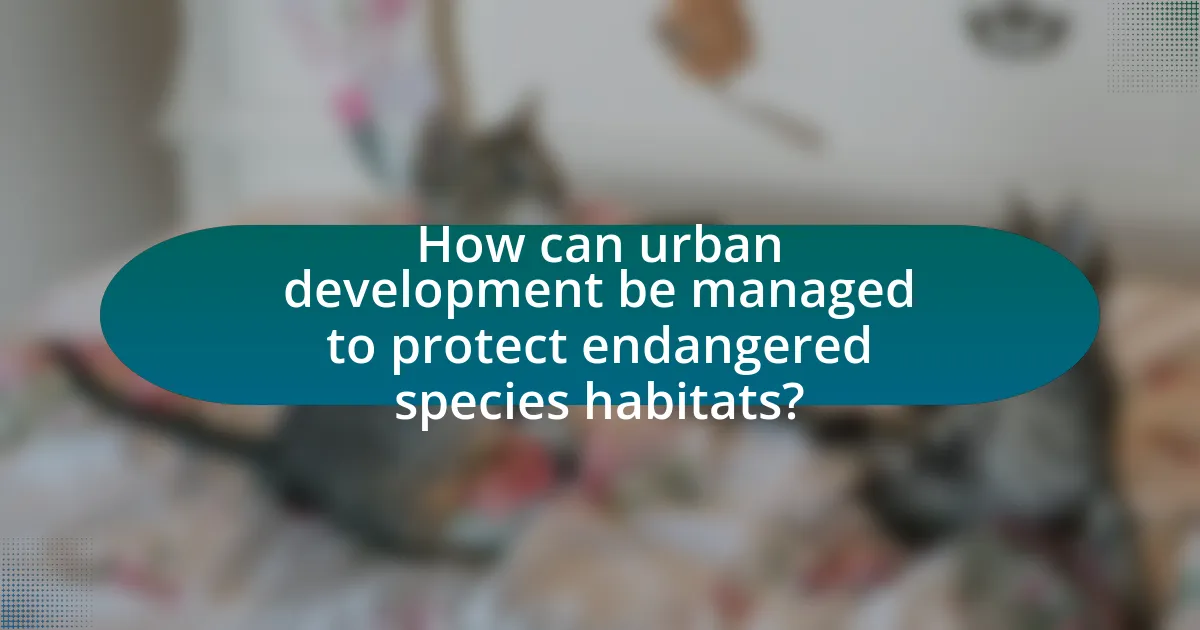
How can urban development be managed to protect endangered species habitats?
Urban development can be managed to protect endangered species habitats by implementing strict zoning regulations and conservation easements. Zoning regulations can designate specific areas for development while preserving critical habitats, ensuring that urban expansion does not encroach on vital ecosystems. Conservation easements legally restrict land use to protect natural resources and habitats, allowing landowners to maintain their property while safeguarding endangered species. Studies show that areas with effective zoning and conservation measures have seen a reduction in habitat loss, thereby supporting biodiversity and protecting endangered species. For instance, the U.S. Endangered Species Act has been instrumental in preserving habitats through such regulatory frameworks, demonstrating the effectiveness of these management strategies.
What strategies can be implemented to mitigate habitat loss?
To mitigate habitat loss, implementing strategies such as establishing protected areas, promoting sustainable land-use practices, and restoring degraded habitats is essential. Protected areas, like national parks and wildlife reserves, safeguard critical habitats from urban development and human encroachment, thereby preserving biodiversity. Sustainable land-use practices, including zoning regulations and eco-friendly urban planning, minimize habitat fragmentation and ensure that development occurs in a manner that is less harmful to wildlife. Additionally, habitat restoration initiatives, which involve replanting native vegetation and rehabilitating ecosystems, can help recover areas that have been previously degraded by urban expansion. These strategies collectively contribute to the conservation of endangered species and their habitats, as evidenced by successful case studies in various regions where such measures have led to increased wildlife populations and improved ecosystem health.
How can urban planning incorporate wildlife conservation efforts?
Urban planning can incorporate wildlife conservation efforts by integrating green spaces, wildlife corridors, and sustainable land-use practices into development plans. For instance, creating parks and natural reserves within urban areas can provide habitats for various species, while wildlife corridors can facilitate safe movement between fragmented habitats. Research indicates that urban green spaces can support biodiversity; a study published in “Ecological Applications” found that urban parks can host a significant number of bird species, demonstrating their role in conservation. Additionally, implementing zoning regulations that protect critical habitats from development can further enhance conservation efforts within urban planning frameworks.
What role do green spaces play in urban environments?
Green spaces play a crucial role in urban environments by enhancing biodiversity, improving air quality, and providing recreational areas for residents. These areas serve as habitats for various species, contributing to ecological balance within cities. Research indicates that urban green spaces can support up to 30% of urban biodiversity, acting as vital refuges for endangered species. Additionally, studies show that trees and vegetation in urban settings can reduce air pollution by up to 30%, thereby improving public health. Furthermore, green spaces offer social benefits, promoting mental well-being and community cohesion among urban populations.
What are some successful case studies of urban development and habitat protection?
Successful case studies of urban development and habitat protection include the High Line in New York City and the restoration of the San Francisco Bay. The High Line transformed an abandoned elevated railway into a public park, preserving native plant species and providing habitat for urban wildlife while promoting sustainable urban development. The project has led to increased biodiversity and community engagement, demonstrating that urban spaces can coexist with natural habitats. Similarly, the San Francisco Bay restoration project has focused on habitat protection for endangered species like the California clapper rail and salt marsh harvest mouse, involving the removal of invasive species and the restoration of tidal marshes. This initiative has resulted in improved water quality and enhanced habitats, showcasing effective urban planning that prioritizes ecological health alongside development.
How have cities balanced growth and conservation effectively?
Cities have effectively balanced growth and conservation by implementing sustainable urban planning practices that prioritize green spaces and biodiversity. For instance, many cities have adopted zoning laws that protect natural habitats while allowing for controlled development, ensuring that urban expansion does not encroach on critical ecosystems. Additionally, initiatives such as green roofs, urban forests, and wildlife corridors have been integrated into city designs, promoting both ecological health and urban livability. Evidence of this approach can be seen in cities like Singapore, which has successfully combined high-density development with extensive greenery, resulting in a 47% green cover while accommodating a growing population.
What lessons can be learned from these case studies?
The lessons learned from case studies on urban development threatening endangered species habitats include the critical importance of integrating conservation efforts into urban planning. These case studies demonstrate that proactive measures, such as creating wildlife corridors and implementing zoning regulations that protect natural habitats, can significantly mitigate the negative impacts of urbanization on biodiversity. For instance, research indicates that cities that prioritize green spaces and sustainable development practices experience lower rates of species decline, highlighting the effectiveness of such strategies in preserving endangered species.
What practical steps can individuals take to support habitat protection?
Individuals can support habitat protection by participating in local conservation efforts, such as volunteering for habitat restoration projects and supporting organizations focused on wildlife preservation. Engaging in community clean-up events helps reduce pollution that can harm local ecosystems. Additionally, individuals can advocate for sustainable urban planning by attending city council meetings and promoting policies that prioritize green spaces and wildlife corridors. Supporting legislation aimed at protecting endangered species, such as the Endangered Species Act, further contributes to habitat preservation. According to the U.S. Fish and Wildlife Service, habitat loss is a primary threat to endangered species, making these actions crucial for their survival.
